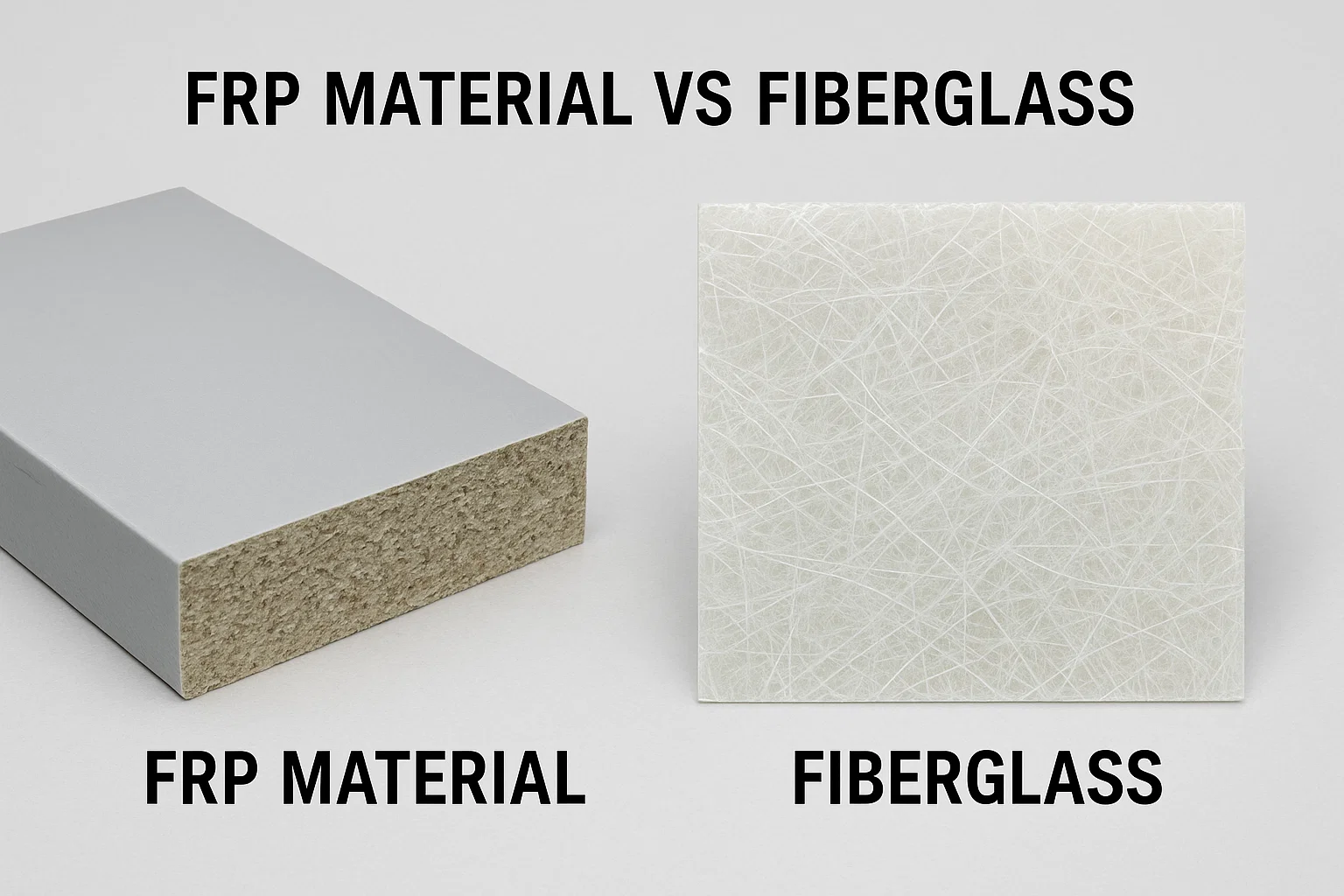Introduction
Sky‑high steel prices, tighter maintenance budgets, and net‑zero commitments have pushed many engineering teams to re‑examine long‑trusted materials. That search often narrows to FRP material vs fiberglass, two cousins that look alike at first glance yet behave—and cost out—very differently over decades of service. This guide breaks down where the dollars go, from purchase order to 20‑year asset plan, so procurement leads can defend their choice with hard numbers. Unicomposite, an ISO‑certified pultrusion manufacturer, routinely supports such analyses with factory testing data and real‑world case histories.

frp material vs fiberglass
Understanding FRP and Traditional Fiberglass
Composition & Manufacturing Methods
Bulk “fiberglass” usually means chopped‑strand mat hand‑lay‑ups or spray‑ups bound with polyester resin. FRP (fiberglass‑reinforced plastic) profiles produced by pultrusion use continuous rovings precisely oriented in a heated die, yielding uniform strength and tight dimensional tolerance. Resin choices expand to vinyl‑ester and epoxy, raising chemical resistance.
Key Mechanical & Chemical Properties Driving Lifecycle Cost
Continuous fibers grant pultruded FRP tensile strengths up to 1,100 MPa—double that of general‑purpose fiberglass laminates. Water absorption drops below 0.8 %, which slashes blistering and freeze‑thaw failures that trigger early replacement in outdoor builds. An ASCE durability survey found pultruded FRP handrails averaged 0.3 maintenance interventions per decade—one‑sixth of painted steel.
Up‑Front Cost Comparison
Raw Material Prices, Labor, and Tooling Requirements
Commodity fiberglass panels still undercut pultruded FRP by 15–25 % per kilogram. Yet labor swings the equation: a 2024 bid review across five fabrication shops showed that installing prefab FRP grating required 40 % fewer man‑hours than cutting and laminating custom fiberglass sheets onsite. One Unicomposite customer—an OEM of cooling‑tower louvers—trimmed assembly time from eight to five hours per unit, offsetting higher material rates after just the second production run.
Design Complexity, Custom Profiles, and Minimum Order Quantities
Complex cross‑sections drive cost in open‑mold fiberglass because each part needs a hand‑finished plug. Pultrusion amortises tooling across unlimited run length; dies on Unicomposite’s lines start around US $3,000 versus about US $8,000 for matched‑metal compression molds. Typical MOQ for a bespoke beam or angle is 500 meters, realistic for industrial buyers.
Operational Savings Over Service Life
Corrosion Resistance & Maintenance Reduction
An anonymised coastal wastewater plant replaced 316 SS stair treads with pultruded FRP equivalents in 2018. Five years later, chloride pitting had already forced spot repairs on adjacent stainless rails, while the FRP treads showed zero section loss. The facility logged annual maintenance savings of US $5,600—a 67 % cut, largely from eliminating abrasive blasting and repaint cycles.
Weight Savings: Lower Freight, Easier Installation
Pultruded FRP weighs roughly one‑quarter of steel and 30 % less than hand‑lay‑up fiberglass of equal stiffness. Crane records from a Texas transmission‑pole project revealed an 18‑minute average lift versus 32 minutes for fiberglass cross‑arms, translating to about US $1,050 per day in hoisting cost avoidance.
Quantifying ROI: Models & Calculations
Net Present Value of Maintenance vs. Replacement Cycles
Simple NPV modeling at a 5 % discount rate shows that an FRP cooling‑tower frame—priced 22 % above fiberglass—delivers positive net value after year 7 when factoring reduced recoating every three years. Spreadsheet‑ready formula:
where t = service year and r = discount rate.
Payback Period Examples in Utility Poles & Agricultural Framing
Utility: Swapping 45‑foot distribution poles to pultruded FRP adds US $350 per pole but saves US $90 annually in truck roll and insulation hardware—payback lands at 3.9 years.
Agriculture: A greenhouse integrator trialed FRP C‑channels for drip‑line supports—payback of 2.5 years once avoided zinc‑rich runoff fines were counted.
Beyond Dollars: Risk, Compliance & ESG
Safety Factors, Dielectric Strength, Regulatory Credits
Because continuous‑fiber FRP is non‑conductive (dielectric strength ≈ 100 kV/in), utilities can down‑rate clearance zones and reduce worker PPE requirements. OSHA data show a 12 % drop in arc‑flash incidents on lines rebuilt with FRP cross‑arms. Several insurers now offer premium credits up to 3 % for installations certified under ASTM D4923.
Sustainability Metrics and Carbon Footprint Reporting
Life‑cycle assessment by the European Composites Industry Association counts 1.7 kg CO₂e per kg of pultruded FRP—35 % lower than open‑mold fiberglass, thanks to near‑zero waste and lower cure energy. That delta feeds directly into Scope 3 reporting for OEM sustainability scorecards.
Conclusion
Choosing between FRP material vs fiberglass is less about today’s invoice and more about the cash tied up in downtime, repairs, and compliance headaches. Field data show pultruded FRP recovers its premium within four years and keeps paying dividends for two decades. Partnering with a specialist like Unicomposite provides tailored profiles, small‑batch prototyping, and engineering calculators that show finance teams exactly where the savings land.
Ready to see the math on your project? Request a no‑obligation ROI analysis or a custom quote today.
Frequently Asked Questions
Q1. Can FRP profiles match my existing fiberglass parts without redesign?
Yes. Pultrusion dies can replicate most geometries, and Unicomposite engineers often adjust fiber layups so drop‑in replacements meet or exceed original load specs.
Q2. How long can FRP stay outdoors before UV affects strength?
With a 0.3 mm surfacing veil and UV‑stabilised resin, mechanical properties remain above 95 % of original after 20 years per ASTM G154 accelerated tests.
Q3. What are typical lead times for custom pultruded beams?
Standard colours ship in 3–4 weeks once a die is approved; first‑article samples can be expedited in 10 days for urgent shutdown projects.
Q4. Is FRP recyclable at end of life?
Thermoset composites can be mechanically ground and reused as filler in cement or new panels, reducing landfill volume by up to 80 %.
Q5. Do I need special fasteners or tools to work with FRP onsite?
No. High‑speed steel or carbide bits handle drilling, and stainless self‑tappers or nylon rivets prevent galvanic issues; no hot‑work permits are needed.
 info@unicomposite.com
info@unicomposite.com


























